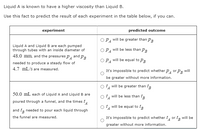
Introduction to Chemical Engineering Thermodynamics
8th Edition
ISBN: 9781259696527
Author: J.M. Smith Termodinamica en ingenieria quimica, Hendrick C Van Ness, Michael Abbott, Mark Swihart
Publisher: McGraw-Hill Education
expand_more
expand_more
format_list_bulleted
Question
thumb_up100%

Transcribed Image Text:**Educational Content on Viscosity Experiments**
**Introduction**
Liquid A is known to have a higher viscosity than Liquid B. Use this fact to predict the result of each experiment described below.
**Experiments and Predictions**
| **Experiment** | **Predicted Outcome** |
|----------------|------------------------|
| Liquid A and Liquid B are each pumped through tubes with an inside diameter of 48.0 mm, and the pressures \(P_A\) and \(P_B\) needed to produce a steady flow of 4.7 mL/s are measured. | ○ \(P_A\) will be greater than \(P_B\) <br> ○ \(P_A\) will be less than \(P_B\) <br> ○ \(P_A\) will be equal to \(P_B\) <br> ○ It's impossible to predict whether \(P_A\) or \(P_B\) will be greater without more information. |
| 50.0 mL each of Liquid A and Liquid B are poured through a funnel, and the times \(t_A\) and \(t_B\) needed to pour each liquid through the funnel are measured. | ○ \(t_A\) will be greater than \(t_B\) <br> ○ \(t_A\) will be less than \(t_B\) <br> ○ \(t_A\) will be equal to \(t_B\) <br> ○ It's impossible to predict whether \(t_A\) or \(t_B\) will be greater without more information. |
**Explanation of Concepts**
- **Viscosity**: A measure of a fluid's resistance to flow. A higher viscosity indicates a thicker fluid.
- **Pressure (\(P\)) and Flow Rate**: In the first experiment, higher viscosity requires greater pressure to maintain the same flow rate.
- **Pouring Time (\(t\))**: In the second experiment, higher viscosity results in a longer time to pour the same volume through a funnel.
Expert Solution
arrow_forward
Step 1
Given:
Liquid A has higher values of viscosity than the liquid B
Viscosity is a measure of a fluid's resistance to flow. It describes the internal friction of a moving fluid. A fluid with large viscosity resists motion because its molecular makeup gives it a lot of internal friction. A fluid with low viscosity flows easily because its molecular makeup results in very little friction when it is in motion.
The viscosity of liquid A is greater than the viscosity of liquid B, therefore, the pressure of liquid A is also more than the pressure of liquid B because more pressure is needed for a steady flow in liquid A.
Therefore, pA will be greater than pB, which is the predicted outcome.
option (a) is correct.
Step by stepSolved in 2 steps

Knowledge Booster
Recommended textbooks for you
 Introduction to Chemical Engineering Thermodynami...Chemical EngineeringISBN:9781259696527Author:J.M. Smith Termodinamica en ingenieria quimica, Hendrick C Van Ness, Michael Abbott, Mark SwihartPublisher:McGraw-Hill Education
Introduction to Chemical Engineering Thermodynami...Chemical EngineeringISBN:9781259696527Author:J.M. Smith Termodinamica en ingenieria quimica, Hendrick C Van Ness, Michael Abbott, Mark SwihartPublisher:McGraw-Hill Education Elementary Principles of Chemical Processes, Bind...Chemical EngineeringISBN:9781118431221Author:Richard M. Felder, Ronald W. Rousseau, Lisa G. BullardPublisher:WILEY
Elementary Principles of Chemical Processes, Bind...Chemical EngineeringISBN:9781118431221Author:Richard M. Felder, Ronald W. Rousseau, Lisa G. BullardPublisher:WILEY Elements of Chemical Reaction Engineering (5th Ed...Chemical EngineeringISBN:9780133887518Author:H. Scott FoglerPublisher:Prentice Hall
Elements of Chemical Reaction Engineering (5th Ed...Chemical EngineeringISBN:9780133887518Author:H. Scott FoglerPublisher:Prentice Hall
 Industrial Plastics: Theory and ApplicationsChemical EngineeringISBN:9781285061238Author:Lokensgard, ErikPublisher:Delmar Cengage Learning
Industrial Plastics: Theory and ApplicationsChemical EngineeringISBN:9781285061238Author:Lokensgard, ErikPublisher:Delmar Cengage Learning Unit Operations of Chemical EngineeringChemical EngineeringISBN:9780072848236Author:Warren McCabe, Julian C. Smith, Peter HarriottPublisher:McGraw-Hill Companies, The
Unit Operations of Chemical EngineeringChemical EngineeringISBN:9780072848236Author:Warren McCabe, Julian C. Smith, Peter HarriottPublisher:McGraw-Hill Companies, The

Introduction to Chemical Engineering Thermodynami...
Chemical Engineering
ISBN:9781259696527
Author:J.M. Smith Termodinamica en ingenieria quimica, Hendrick C Van Ness, Michael Abbott, Mark Swihart
Publisher:McGraw-Hill Education

Elementary Principles of Chemical Processes, Bind...
Chemical Engineering
ISBN:9781118431221
Author:Richard M. Felder, Ronald W. Rousseau, Lisa G. Bullard
Publisher:WILEY

Elements of Chemical Reaction Engineering (5th Ed...
Chemical Engineering
ISBN:9780133887518
Author:H. Scott Fogler
Publisher:Prentice Hall


Industrial Plastics: Theory and Applications
Chemical Engineering
ISBN:9781285061238
Author:Lokensgard, Erik
Publisher:Delmar Cengage Learning

Unit Operations of Chemical Engineering
Chemical Engineering
ISBN:9780072848236
Author:Warren McCabe, Julian C. Smith, Peter Harriott
Publisher:McGraw-Hill Companies, The